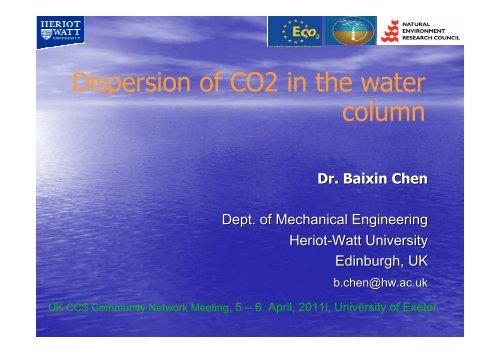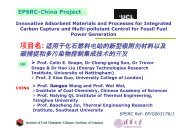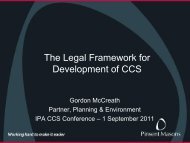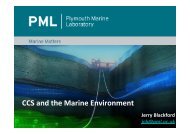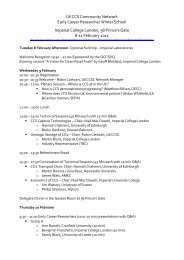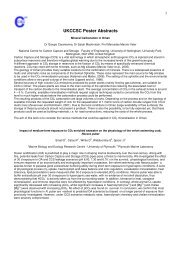Dispersion of CO2 in the water column
Dispersion of CO2 in the water column
Dispersion of CO2 in the water column
You also want an ePaper? Increase the reach of your titles
YUMPU automatically turns print PDFs into web optimized ePapers that Google loves.
<strong>Dispersion</strong> <strong>of</strong> <strong>CO2</strong> <strong>in</strong> <strong>the</strong> <strong>water</strong><strong>column</strong>Dr. Baix<strong>in</strong> ChenDept. <strong>of</strong> Mechanical Eng<strong>in</strong>eer<strong>in</strong>gHeriot-Watt UniversityEd<strong>in</strong>burgh, UKb.chen@hw.ac.ukUK CCS Community Network Meet<strong>in</strong>g, 5 – 6 April, 2011l, University <strong>of</strong> Exeter
<strong>CO2</strong> under seabed storage and challenge:Leakage prediction and risk management<strong>CO2</strong> leakage mechanisms (IPCC SRP on CCS, Chapter 5, 2005)control +500ppm +1000ppm +2000ppm+5000ppm +10000ppmMorphology <strong>of</strong> Sea Urch<strong>in</strong> Larva (Kurihara & Shirayama, 2004)
Model Syn<strong>the</strong>sis (WP2 + WP6.3 <strong>of</strong> QICS)physicsWP 1RISCSWP 2.3L-BsedimentdispersionWP 2.1 and2.2: Bubble /plumedispersionWP 2.5 F<strong>in</strong>escalehydrodynamicsFSPOLCOMS /FVCOMPOLCOMS1.8kmresolutionshelf model<strong>CO2</strong> propagationSet <strong>of</strong> exposure scenarios at epicentre, locality and region8.5pH87.576.5scenario 1scenario 26scenario 35.50 10 20 30 40 50time, daysUse <strong>the</strong>se to drive 1D ERSEMSystem impact
Outl<strong>in</strong>e <strong>of</strong> <strong>the</strong> presentationI. BackgroundII. Modell<strong>in</strong>g <strong>of</strong> <strong>CO2</strong> dispersion <strong>in</strong> asmall-scale oceana) Dynamics <strong>of</strong> <strong>CO2</strong> drop/bubble <strong>in</strong>sea<strong>water</strong>• Numerical models developed• Model calibration with observation datafrom Lab. and small scale field Exp.b) Model application: <strong>Dispersion</strong> <strong>of</strong>Leaked <strong>CO2</strong> from North seabedIII. Summary and suggestions
BackgroundSea surfaceDepthSediments layer(hydrate form ableCap rockGeo-formationsNatural gas or oil (EOR)Geo-formationsCO 2 solutionplumes<strong>CO2</strong> plumeunder seabedUnder seabed:• Multi-fluid/phase• Porous media, stratification• Interface actions (fluids and fluid/solids)Sediments:• <strong>CO2</strong> hydrate formationCO 2 leaked tooceanOcean:Sal<strong>in</strong>e <strong>water</strong> reservoirs•Turbulent boundary layer•Multi-fluid plume•Stratification, free surface•Bubble/drop dynamics•Chemical/Bio-impacts
Scales and <strong>the</strong> roles <strong>of</strong> ocean turbulence ondispersions <strong>of</strong> leaked <strong>CO2</strong> <strong>in</strong> <strong>the</strong> oceanOGCMs T ~ centuriesTurbulent K<strong>in</strong>etic Energies Log (Ek)Regional oceanmodel T ~ yearsMeso-scale oceanmodel & Eng<strong>in</strong>eer<strong>in</strong>gfield Exp. T ~ weeksSmall-scale two-fluidflows model & smallfield Exp. T ~ hoursThis presentationDroplet dynamics &Lab. Exp. T ~ hrs100km 1.0km 1.0mScalesBackground energy spectra from Wood, Science 1999
Theory and methodology for two-phasesmall-scale turbulent ocean modelLarge-scale <strong>in</strong>formationfrom Boundaries :Mean properties (X,t)Turbulent propertiesat K > KfData analysisField Obs. DataInside <strong>of</strong> small-scalescaleocean: N-S S based 3-D 3 D unsteadyGovern<strong>in</strong>g Eq.s for <strong>CO2</strong> &sea<strong>water</strong> Forced-dissipative dissipative Energycascade <strong>the</strong>ories Adjusted by observationspectrum
Govern<strong>in</strong>g Eq.s <strong>of</strong> two-fluid smallscaleturbulent ocean∂Govern<strong>in</strong>g Eq.s <strong>of</strong> Sea<strong>water</strong>∂ρ∂ρû+∂t∂xi∂ρuˆ∂tρφk∂tˆi∂ρuuˆiˆj+∂xji=&w dco∂pˆ∂Dij= − + + ( ρ − ρ 0)g∂xi∂xj+ ( F&d)+ Ffδij∗∂pˆ∂P= − ρ 0gi∂xi∂xi∂ρφˆ kûj∂ ∂ ˆ φk∂ρqˆ+ = ( ρDk) +∂xj∂xj∂xj∂xjk+ w&idcoδklGovern<strong>in</strong>g Eq.s <strong>of</strong> <strong>CO2</strong> plume∂nˆ∂td∂nˆdû+∂xjdj∂ˆα ∂ˆûα+∂t∂xjρd∂ û∂tdidj=∂ρ+∂xjqˆdn= qˆdûûdi djdα−w&∂ ˆ=∂xjρτ d dijdco/ρd+ ˆ( αρd−ρw)g i −(F&dco) iCoupled by source terms highlighted by underl<strong>in</strong>es, which are<strong>the</strong> models <strong>of</strong> <strong>CO2</strong> droplet/bubbles, LES turbulent model anddensity change model <strong>of</strong> <strong>CO2</strong> solution.
Turbulent k<strong>in</strong>etic energy spectrum(cm 2 s -2 )Turbulent k<strong>in</strong>etic energy spectrum(m 2 s -2 )10 010 -110 -210 -310 -4EXP data fromKeahole Pt. Off<strong>in</strong>gN-S DirectionModel<strong>in</strong>g10 -510 -4 10 -3 10 -210 010 -110 -210 -310 -4EXP data fromKeahole Pt. <strong>of</strong>f<strong>in</strong>gE-WExample <strong>of</strong> reconstruction <strong>of</strong> smallscaleturbulent oceanHzModel<strong>in</strong>g10 -510 -4 10 -3 10 -2Hz(Chen et al, Direct and Large-Eddy Simulation, 2005)W-E (km)N-S (km)Model<strong>in</strong>g prediction <strong>of</strong> turbulent k<strong>in</strong>etic energy(TKE <strong>in</strong> m 2 s -2 ) distribution on a horizontalsection at depth <strong>of</strong> 750 m (Keahole case)Experimental data obta<strong>in</strong>ed by CREIPI at Keahole Pt. Off<strong>in</strong>g(19 o 43.324N; 156 o 04.806W)
<strong>CO2</strong> droplet/bubble ModelsAn <strong>in</strong>tegrated model <strong>of</strong> <strong>CO2</strong>droplet/bubble leaked fromseabeda) Sub-model <strong>of</strong> <strong>CO2</strong> properties• <strong>CO2</strong> solubility• <strong>CO2</strong> phase diagramb) Sub-model <strong>of</strong> <strong>in</strong>dividual <strong>CO2</strong> droplet/bubble• Momentum exchange sub-model• Mass transfer sub-model
<strong>CO2</strong> Phase diagram
Govern<strong>in</strong>g Eq.s <strong>of</strong> a Drop/Bubble <strong>in</strong>sea<strong>water</strong>Momentum exchange Eq.dudtr 2ρsρc3urd ln( mc= ((1.0 − ) g − Cd) − u)rρcρs4DdtMass Eq.dddte=−1ρcd(3ur: slip velocityedρcdt+ 2k( Cde: equivalent diameter <strong>of</strong> bubbleCs: solubilityρ : densitys−C 0))Dissolution<strong>CO2</strong>BuoyancyDragKey Parameters:• k : mass transfer coefficient•Cs: <strong>CO2</strong> solubility•Cd: drag coefficientShape (spherical ordeformed) & <strong>in</strong>terfaces(solid, liquid, and gas to<strong>water</strong>)
Model validation: <strong>CO2</strong> droplet <strong>in</strong>deep oceanDroplet Diameter (cm)Droplet velocity model<strong>in</strong>g vs data(Nikolaus et al. EST, 2008)1.000.800.600.400.200.00:Observation Data <strong>of</strong> Droplet A(P. Brewer et al):Observation Data <strong>of</strong> Droplet B(P. Brewer et al)10 25 40 55 70Elapsed Time (m<strong>in</strong>)Model<strong>in</strong>g Prediction (Droplet A)Model<strong>in</strong>g Prediction (Droplet B)Droplet dissolution model<strong>in</strong>g vs data(Chen et al, JGR 2005 and field Exp data by P. Brewer et al, EST, 2003)
Model validation: <strong>CO2</strong> bubble <strong>in</strong>shallow oceanADCP backscatter show<strong>in</strong>g bottom“flares” (red signal) at Salt Dome Juist,north sea. <strong>CO2</strong> bubble size (de) 4 – 8mm. (F. Daniel et al, University <strong>of</strong> Kiel, to bepublished by JGR)Numerical simulation <strong>of</strong> <strong>CO2</strong>bubbles leaked from seabed(Chen et al, GHGT-9, 2008)
Model validation: Field Exp <strong>of</strong> direct<strong>in</strong>jection <strong>of</strong> L<strong>CO2</strong> <strong>in</strong>to <strong>the</strong> oceanLocation : Monterey Bay(Tubeworm Slump(36.6417 N, 122.4158W) Motivations:ooTest new AcousticSonar system formonitor<strong>in</strong>g<strong>CO2</strong> plumedynamics Time: 17 ~ 21, Nov. 2005
<strong>CO2</strong> droplet plume monitored (right top) and (right-bottom)(Brewer & Chen et al, GRL 2006)Western FlyerOne Sonar fromsurface ship forvertical detective800m900m10000 5 10 15 20 25 30Time s<strong>in</strong>ce CO 2 release (m<strong>in</strong>utes)ROVAno<strong>the</strong>r Sonar <strong>in</strong>ROV for horizontaldetective
Acoustic Detection (top) and model<strong>in</strong>g (bottom) <strong>of</strong><strong>CO2</strong> plume at horizontal (Brewer & Chen et al, GRL 2006)
Application example: <strong>Dispersion</strong> <strong>of</strong>leaked <strong>CO2</strong> from North seabedTerrametrics, 2011Npd.no•<strong>CO2</strong> leakage parameters:• Leakage rates: 0.5 kg/s/m²• Ocean current: 0.5, 0.05 m/s• Initial bubble sizes: 10, 15 30 mm•Leakage site:• North sea (58.53N 0.21E)• Leakage depths:30m, 82m; 150m
<strong>CO2</strong> bubble (left) and <strong>CO2</strong> enriched<strong>water</strong> plumes at T=1.0hrLeakage depth: 150m; de=10 mm; Uc = 0.5m/s; <strong>CO2</strong>leakage rate: 0.5kg/m2/sFrom 150m depth (m)Along <strong>the</strong> current (km)Along <strong>the</strong> current (km)
Volume <strong>of</strong> <strong>CO2</strong> enriched plumewith pH changesCase123456Leakagedepth(m)150M150M80M80M30M30MSeasonSummerW<strong>in</strong>terSummerW<strong>in</strong>terSummerW<strong>in</strong>ter<strong>CO2</strong> enriched plum e volum e (m ^3)1.0E+071.0E+061.0E+051.0E+041.0E+031.0E+021.0E+01Volume <strong>of</strong> <strong>CO2</strong> enriched <strong>water</strong> plumewith pH change >0.01Volume <strong>of</strong> <strong>CO2</strong> enriched <strong>water</strong> plumewith pH chnage > 0.5Volume <strong>of</strong> <strong>CO2</strong> enriched <strong>water</strong> plumewith pH change > 1.0Volume <strong>of</strong> <strong>CO2</strong> enriched <strong>water</strong> plumewith pH change > 1.5All cases: De = 15 mm;Uc = 0.05 m/s; T=1.0 hr;1.0E+001 2 3 4 5 6Case No
Effects <strong>of</strong> current, leakage depth,rate and bubble sizeMax height <strong>of</strong>sea<strong>water</strong> plume (m)Effective volume perunit width <strong>of</strong> pHDistribution (m²)Maximum pHchangeBase Case 13.35 24033 1.571Ocean current: 0.0m/s15.82 4270 2.832Leakage depth:150m<strong>CO2</strong> leakage rate:1.0 kg/m2/sInitial bubble size:30 mm15.41 27730 1.57214.99 26991 1.85427.37 49272 1.101
• Summary:Summary and suggestions– A two-phase model <strong>of</strong> leaked <strong>CO2</strong> dispersion <strong>in</strong>small scale turbulent ocean is developed– Model is validated by available Lab. and filedobservation data from shallow and deep ocean• Improvements:– More field exp data <strong>of</strong> <strong>CO2</strong> bubble/drop plume– Model <strong>of</strong> <strong>CO2</strong> phase transition (depth 400 – 300m)– Model <strong>of</strong> bubble/drop <strong>in</strong>teractions• Nest<strong>in</strong>g to <strong>the</strong> mesoscale model (QICS)• Development and nest<strong>in</strong>g to <strong>the</strong> model <strong>of</strong> <strong>CO2</strong>dispersion through sediments (QICS)
Acknowledgements• Dr. Peter Brewer <strong>of</strong> MBARI, USA, forcollaboration on <strong>CO2</strong> field observations.• Mr. Jerry Blackford, , PML, project leader andmodell<strong>in</strong>g collaboration.• Mr. Marius Dewar, student <strong>of</strong> Heriot-WattUniversity, performed <strong>the</strong> Case studiesF<strong>in</strong>ancial support<strong>in</strong>g from projects <strong>of</strong> QICS,NERC and E<strong>CO2</strong>, EU-F7.
WP 2.5 Physical coupl<strong>in</strong>g <strong>of</strong> f<strong>in</strong>e scale and regional hydrodynamicmodelsPreviously we have resolved ‘events’at ra<strong>the</strong>r coarse scales based on <strong>the</strong>POLCOMS – ERSEM platform.Huge leakThe challenge is to resolve <strong>the</strong> localscale:Two possible approaches:Nest<strong>in</strong>g ei<strong>the</strong>r200m scale POLCOMS (tried and trusted)FVCOM model which resolves down to 5m (new technology)
Lab. Exp on <strong>CO2</strong>/CO/<strong>CO2</strong> solution atcapillary-scale poursp outε : Porosity <strong>of</strong>geo-formationsρ wρ Cρ sρ Cb oyChemicalreactionswith solidgra<strong>in</strong>sµρ sρ wρ C < ρ w < ρ sp <strong>in</strong>Geo fluids: salt<strong>water</strong> and oilCO 2 (Liquid or supercritical)CO 2 <strong>water</strong>/oil solutionsor CO 2 hydrateMicroscope + High speed CCDcameraInte raction a mon g CO 2, CO 2 solutio ns, ge o-flu id s, geo-gra <strong>in</strong>s
Prelim<strong>in</strong>ary ExperimentsT= 10 sec T= 120 m<strong>in</strong>s<strong>CO2</strong> bubble shr<strong>in</strong>k<strong>in</strong>g <strong>in</strong> a chancel (d<strong>in</strong> =2.8mm) at atmosphere pressure andtemperatureDemonstrat<strong>in</strong>g exp set up:micro-pump test<strong>in</strong>gChallenge: (RA’s work)• Suitable exp set up withMicroscopic system and capillarypressure• Observation <strong>of</strong> micro-dissolution(Micro-PIV?)
LBM model <strong>of</strong> <strong>CO2</strong> dispersion anddissolution <strong>in</strong> pore scaleAdvantage:• First pr<strong>in</strong>ciple from Boltzmanndistribution• Direct treatment <strong>of</strong> <strong>in</strong>terfaceactionsSpecifics:• Physic space – Dimensionless ---LBM spaceDistribution fonction: fa( x,ea,t)Macroscopic density:Macroscopic velocity:ρ =8∑a = 0f a1∑8a=0u = f . e aρa
LBM - test<strong>in</strong>gT= 0; 900 1700 2500 3500Bubble ris<strong>in</strong>g <strong>in</strong> a channel (LBM)Challenge: (RA + PhD)• <strong>CO2</strong>/Water system (EOS)• Dissolution model (no one available)
• Sept-10– Sept. 11:Prelim<strong>in</strong>ary Schedule– Task 2.1– Task 2.2 (Small-scale ocean model)– Task 2.3 (Prelim<strong>in</strong>ary Lab exp: dispersion rate)– Task 2.3 LBM: <strong>CO2</strong> EOS, <strong>in</strong>terface tension• Sept 11 – Sept. 12:– Task 2.2: Coupl<strong>in</strong>g Small-scale ocean and bubble model– Task 2.3 Lab exp: dissolution rate– Task 2.3 LBM: Dissolution model• Sept, 12 – Sept. 13– Task 2.2: Modell<strong>in</strong>g simulations and nest<strong>in</strong>g to meso-scale scale model(WP2.5)– Task 2.3 Lab exp data analysis and model development– Task 2.3 LBM: Coupl<strong>in</strong>g dispersion and dissolution and casesimulations
a. Forced-dissipative system <strong>of</strong> small-scaleocean:∂ ρû∂tIII-2. Govern<strong>in</strong>g equations for reconstruct<strong>in</strong>g asmall-scale turbulent ocean(Chen et al, Tellus, 2003)i∂ρûiûj+∂xjForced term:Ff∂pˆ= −∂xiDissipative term:Dik′∂D+∂xjij+ ( ρ − ρ 0 )g= ρεu0(k,t)/ ∑ uk ∈ k 0(k,t)u 0= 2ρνktSi+ ( F&d) +Ffδijb. Structure function turbulent viscosity model∑ikk2F = × − − ∆20.25( uk(xk)uk(xkxk))−3/ 2k( xk , ∆xk) = 0.15C∆xk[ F ( xk,∆xk)]kνtk2f′′(k,t)k∈kf
Bubble dynamics <strong>in</strong> sedimentsAn X-Ray CT image <strong>of</strong> a sediment with <strong>in</strong>terbandedclay and carbonate sand layers andconta<strong>in</strong><strong>in</strong>g (post-collection?) bubbles <strong>in</strong> bothtypes <strong>of</strong> sediments (black circles and ellipses).Bubbles <strong>in</strong> <strong>the</strong> sands are spherical away frommud contacts, e.g., as <strong>in</strong>dicated by <strong>the</strong> redarrow labelled “a”whereas <strong>the</strong> bubbles <strong>in</strong> <strong>the</strong> muds are oblatespheroids, e.g. as <strong>in</strong>dicated by <strong>the</strong> yellowarrow labelled “b’.Bernard. P. Boudreau, et al, GRL, 2004
LBM- <strong>CO2</strong> dispersion <strong>in</strong> a channel and aporous mediaT= 0; 900 1700 2500 3500Bubble ris<strong>in</strong>g <strong>in</strong> a channel (LBM)Wie, W & Chen; to be submitted
I-3. Characteristics <strong>of</strong> <strong>CO2</strong> droplet &bubbleRe & dv/dhσ =σ =Eo=∆ ρ gdσ2e
Challenge: Mar<strong>in</strong>e environmentalimpacts, risks and risk management For <strong>CO2</strong> under seabed storage, <strong>the</strong>re exists anpotential possibility that stored <strong>CO2</strong> could migrate andleak <strong>in</strong>to <strong>water</strong> <strong>column</strong> at an eng<strong>in</strong>eer<strong>in</strong>g scales, whichwill alter <strong>the</strong> local chemical environment. Lab. experiments have shown that susta<strong>in</strong>ed highconcentrations <strong>of</strong> <strong>CO2</strong> would cause mortality <strong>of</strong> oceanorganisms. The effects <strong>of</strong> leaked <strong>CO2</strong> on mar<strong>in</strong>eorganisms will have ecosystem consequences. The chronic effects <strong>of</strong> leaked <strong>CO2</strong> at an eng<strong>in</strong>eer<strong>in</strong>gscale on ecosystems over large spatial and long timescales have not yet been understood (studied?).
Natural <strong>CO2</strong> plumes <strong>in</strong> <strong>the</strong> ocean<strong>CO2</strong> bubble plume nearPanarea, Italy. (Photo by GiorgioCaramanna, Nott<strong>in</strong>gham University, UK)B: ‘‘Lion chimney,’ active black smokervents . E: Liquid <strong>CO2</strong> droplets from <strong>the</strong>‘<strong>CO2</strong> lake’ <strong>in</strong> Sou<strong>the</strong>rn Ok<strong>in</strong>awa. (FumioInagaki et al, PNAS, 2006)
Bio-impact impact model<strong>in</strong>g test (deep ocean)(Activity <strong>in</strong>dex <strong>of</strong> zooplankton without recover<strong>in</strong>g,Chen et al, JO, 2005pH plumeMc=0.6kg/s; D0 =8.0mmBio-impact <strong>in</strong>dicated by an activity <strong>in</strong>dex <strong>of</strong>zooplankton; 1.0: normal; 0.0: <strong>the</strong> worstT=100.3 m<strong>in</strong>; Target ocean: Ok<strong>in</strong>awa
Bio-impact impact model<strong>in</strong>g test (deep ocean)(Activity <strong>in</strong>dex <strong>of</strong> zooplankton without recover<strong>in</strong>g)Chen et al, JO, 2005pH plumeBio-impact <strong>in</strong>dicated by an activity <strong>in</strong>dex <strong>of</strong>zooplankton; 1.0: normal; 0.0: <strong>the</strong> worstMc=0.1kg/s; D0 =8.0mmT=100.3 m<strong>in</strong>
I-1.What does <strong>the</strong> leaked <strong>CO2</strong> look like?,(Dr. Nakajima, NSRI, Japan)
II-a-2. developed andundeveloped Drop/Bubble modelsDepthGas <strong>CO2</strong>+ HydrateG-H <strong>CO2</strong>-sea<strong>water</strong>(Chen et al, Tellus, 2003)Gas <strong>CO2</strong>G <strong>CO2</strong>-sea<strong>water</strong>(Clift & Crace, 1978;Bozzano et al 2000 )L/G <strong>CO2</strong> phase change ??-500mL-<strong>CO2</strong>L<strong>CO2</strong>-sea<strong>water</strong> (Clift & Crace,1978; Chen et al 2008 )-800mL-<strong>CO2</strong>+ Hydrate9 C 12 CL-H <strong>CO2</strong>-sea<strong>water</strong>(Chen et al, Tellus, 2003)Temperature
II-a-8: ROV observation <strong>of</strong> <strong>CO2</strong>droplet/bubble transitionMonterey Bay, CA (36.7ºN 122.1ºW)Depths: 510m to 380mThe ROV: Ventana
II-a-9. Observation data <strong>of</strong> <strong>CO2</strong> phasetransition and dissolutionRayleigh-Taylor <strong>in</strong>stability:db=4.0 – 5.0 mma ) b) c) d) e) f) g)Droplet/bubble transition (Chen, B & P. Brewer; GRL to be submitted )a) Droplet at 435 m.b) A small bubble appeared at 416m and <strong>in</strong>situtime <strong>of</strong> 12:40:11;c) & d) Liquid part shak<strong>in</strong>g at <strong>in</strong> situ time <strong>of</strong>12:59:02 and 12:59:29;e) First breakup <strong>of</strong> liquid part and formed acoalesce part (top) and a droplet at13:01:09.f) Two separated droplet/bubble departed at13:02:22.g) Second break up occurred from <strong>the</strong> liquidpart <strong>of</strong> <strong>the</strong> coalesce droplet.
II-a-3. Sub-model <strong>of</strong> <strong>CO2</strong> solubility &phase diagramHydrateLiquidGas
C[dd e]II-a-4.Cd for droplet/bubble (Chen et al,= f ( M,Eo,Re,γρ) ⋅[f (Re) = 24(1 + 0.125Re20.72dd)/ Re= 1.0 + (5.6419−8.3484×102]de1). Droplet/Bubble with hydrate film covered:2). Droplet/bubble:f ( M , Eo,Rff[12dde]2e, γ ) =10(1 + 1.3M=10(1 + 1.3Mρρ24Re= 1.5617 − 0.8405γf( R= 1+γ (1.45 −1.079×1011/ 6ρe) + 3.1Eo) + Eo1/ 6γRe−31+12M, γρ)[1+36M−3ρ)=ρCρw+ 1.4596×101/31/3] +f2−6(Chen et al, Tellus,2003 and GHGT9,2008)Re2) × 10−4Eo( γρ)1.4(1 + 30M1.51/ 6Re) + Eo1.5
II-a-5: Sub-model <strong>of</strong> <strong>CO2</strong> drop/bubbledissolutionDroplet with hydrate (Chen et al, 2003):1/ 2 3Sh = ( 2 + 0.69 Re Sc1/ )( A / A )e( ADroplet (Clift & Crace, 1978):eff/Aeq)sheff+ 1.4766×10-5eqRe2sh= 1.0+Re(4.67071 .1871×10) × 10-4-3ReSh=2 2.15 λ(1.0 −(2.89+0.5πRe0.64)0.5(Re⋅Sc)0.5µcλ =µwBubble (Clift & Crace, 1978):K=udDf0.0113(0.45 + 0.2d0.50.065 Df0.0694 d−1/4eDe0.5f)0.5d.5
II-a-10.10. Term<strong>in</strong>al distance and time <strong>of</strong> Leaked<strong>CO2</strong> droplet/bubbleTerm<strong>in</strong>al distance: <strong>the</strong> distance ris<strong>in</strong>g fromleaked depthTerm<strong>in</strong>al time: The time till to completelydissolved
II-b-3. Density change <strong>of</strong> <strong>CO2</strong> solution(Song Y, B.Chen, et al. Energy, 2002)1.0121.013 Sae<strong>water</strong>30 Underground Water (This Study)40 Underground Water (This Study)50 Underground Water (This Study)Density Ratio1.0081.0061.0041.00210 0.01 0.02 0.03 0.04 0.05<strong>CO2</strong> mass fractionThe effects <strong>of</strong> temperature on density ratio
Tasks <strong>of</strong> WP 2 <strong>of</strong> QUICS2.1 Experimental and <strong>the</strong>oretical study <strong>of</strong> <strong>CO2</strong>dynamics <strong>in</strong> sea<strong>water</strong> (HW).2.2 Development <strong>of</strong> small-scale scale two-phaseturbulent ocean modell<strong>in</strong>g (HW, PML)2.3 Parameterisation and modell<strong>in</strong>g <strong>of</strong> <strong>CO2</strong>dispersion <strong>in</strong> sediments. (HW)2.4 Biochemical & ecological models <strong>of</strong> impacts.(PML, NOCS, SAMS)2.5 Physical coupl<strong>in</strong>g <strong>of</strong> f<strong>in</strong>e scale and regionalhydrodynamic models (POL, HW)


